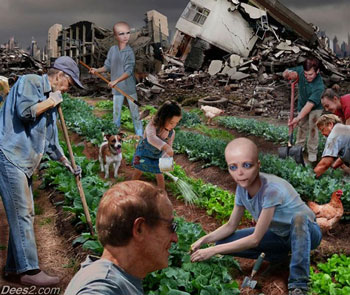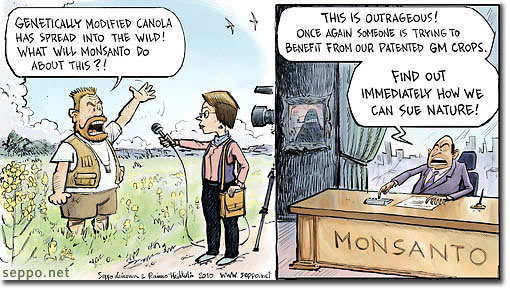Lack of biodiversity: 75% of the world's crop varieties are lost in just the last century
According to a report by Food and Agriculture Organization of the United Nations (FAO), the local food varieties are under a serious threat and as a result, many species and animals are going extinct. According to this report, the scale of loss is so extensive that the disappearance of different crop varieties and breeds can lead to the disappearance of many species and start a chain reaction that will eventually affect everyone on this planet.

Here are some of the facts about loss in Agrobiodiversity (published by FAO):
- In the last century, 75% of the plant genetic diversity has been lost since local farmers and food producers have left their local farms for more industrialized and high-yielding varieties.
- While six breeds of livestock are lost every month, 30% of livestock breeds are at higher risk of extinction.
- Currently, 75% of the world’s food supply is generated from only 12 plants and five animal species.
- Off of 250 000 to 300 000 known plant species that are edible, only 150 to 200 are used by humans, whereas only three (rice, maize and wheat) make up for 60% of calories and proteins obtained by humans from plants.
-30% of human food and agriculture are dependent on animals and 12% of the world’s populations live almost entirely based on products from livestock.
-Many farmers have lost more than 90% of their crop varieties and half of the breeds of many domestic animals have been lost. In fact, all the world’s 17 main fishing grounds are fishing above the sustainable limits and many fish populations are going extinct as a result.
The animal species that have gone extinct including the Persian lion:
Many animal species have gone extinct over the last century, among them Pinta Island Tortoise, Baiji (Yangtze) River Dolphin, Western Black Rhinoceros, Caribbean Monk Seal, many species of birds (such as Canarian Oystercatcher and Ivory-billed Woodpecker), Javan Tiger and Persian lions.

In fact, the Persian lion, the symbol of Iran’s proud and ancient civilization, represents a special breed of lion (only found in Iran), that is now extinct. The Persians sculptured and drew the roaring lions on gates and walls of their palaces. (These sculptures are found in Persepolis, Susa and Hyrcania).
Unfortunately, many Persian lions were hunted by the British (while the British were exploiting Iran’s oil fields and were rubbing Iran’s children off of their birth right) and in fact, the last lion was hunted and killed by a British hunter in Iran back in early 20th century.
The story goes back to 1904, when almost all of Iran’s oil field supplies were controlled and owned by the British monarchy under Anglo-Persian Oil Company (APOC) - simply because they were a superpower with weapons and Persia (as Iran was called then) was a peaceful country with no military. The Anglo-Persian Oil, later on became British Petroleum Company (BP) (after CIA overthrew the first democratically elected prime minister of Iran who tried to nationalize Iran’s oil). The British Petroleum is the same oil company that recently expelled more than 200 million gallons of oil in the Gulf of Mexico and up to today there are reports of deaths and toxicity of dolphins and sea life as a result of BP’s total incompetence and lack of responsibility.
So, what are some of the reasons behind lack of biodiversity?
1. Genetically modified organisms:
GMOs threaten the biodiversity and the future of the organic crops that are essential for global food security. For example Monsanto’s Bt corn, are genetically manipulated by inserting Bt toxin into the DNA of GM corn. Monsanto’s Bt corn are an example of living pollution since every cell of Bt corn produces toxin that can break the stomach of pests with only one bite.
GMOs can also spread and interbreed with other native crops and contaminate the ecosystem, native plants and species. Although, the biotech industry promised that GMOs will provide high-yield fields and reduction in use of chemicals, the recent reports show the exact opposite. Since the introduction of GMOs, the use of chemicals has increased by 527 million pounds. As a result of neonicotinoid class of pesticides, many bee keepers are losing up to 50% of their bee hives and just last year, the California almond growers didn’t have enough bees for pollination and they had to bring over one million colonies from North America.

2. Industrial patenting, intellectual property laws and biotech monopoly:
The giant biotech company, Monsanto has patents on many of its GMO crops and has successfully been able to push many farmers and local producers out of business and force them to pay Monsanto’s Technology Fee (a fee that a farmer has to pay when they are growing GM crops). As mentioned Monsanto’s GM crops are sneaking into our food supply and as a matter of fact, after the discovery of Monsanto’s GE crop in Oregon field, other countries including South Korea, Japan and European Union put a ban on US GMO wheat. Also, after three varieties of unapproved GM rice sneaked into the US commercial rice exports, countries such as Bulgaria and Russia put a ban on US rice while many countries like the European Union, South Korea, Philippines and Japan put more restricted laws and regulations on testing rice imported from US.
As GM crops are sneaking into the world’s food supply, Monsanto is finding ways to sue and harass farmers that their crops have been ruined and contaminated with Monsanto’s GE crops. Reports show that by 2010, Monsanto has had 136 infringement lawsuits against 400 farmers and 53 small businesses.
Monsanto’s monopoly and market control has led to cultivation of fewer crop varieties and breeds and as a result we are seeing a less diverse and a less competitive market. Today, when you walk into a supermarket you have the illusion that you have many choices. Most products found in US grocery store are re-arrangement of corn and soy. Also, in US majority of farm lands are used to grow soy and corn (90% of all soy and corn in US are GMOs) while only 3% of farmlands are used to grow fruits and vegetables.

3. Climate Change and Global warming:
Rapid climate change has led to loss of biodiversity of many species who cannot adapt to the sever climate change. Chemtrails, concentration of greenhouse gasses into the atmosphere, fuel burning power plants, Carbone dioxide release from cars and other means of transportation, release of methane from animals and increase in use of herbicides and chemical fertilizers have led to the rapid climate change.
Raising temperatures and melting glaciers are having major effect on the ecosystem. For example, the polar bears are mostly affected by the negative side effects of rapid change. Polar bears mostly live on ice and melting glaciers are threatening their habitat. Also, they feed mostly on whales, seals and walruses that are going extinct as a result of global warming so, what they usually find to eat has more level of pollution and contamination which can cause lower immune system in Polar bears. http://www.buzzle.com/articles/polar-bears-and-global-warming.html
4. Habitat destruction and loss:
Human population growth is one of the main causes of loss in rainforest biodiversity. Also, local species are much more vulnerable to go extinct since their existence is much more threatened by human activity.
5. Industrial, agricultural and waste-based pollution and contamination:
Pollution our air, water and soil have had devastating results on the ecosystem and the life of the wild life and its inhabitants. The industrial and waste-based pollution is a serious problem in both advanced and developing countries. Some of the recent industrial pollutions are BP’s expel of 200 million gallons of oil in Gulf of Mexico and Fukushima nuclear disaster that is leaking between 150 to 300 tons of radioactive materials into the Pacific ocean. http://www.seattleorganicrestaurants.com/vegan-whole-food/Fukushima-nuclear-disaster-radioactive-leak.php
Resources:


